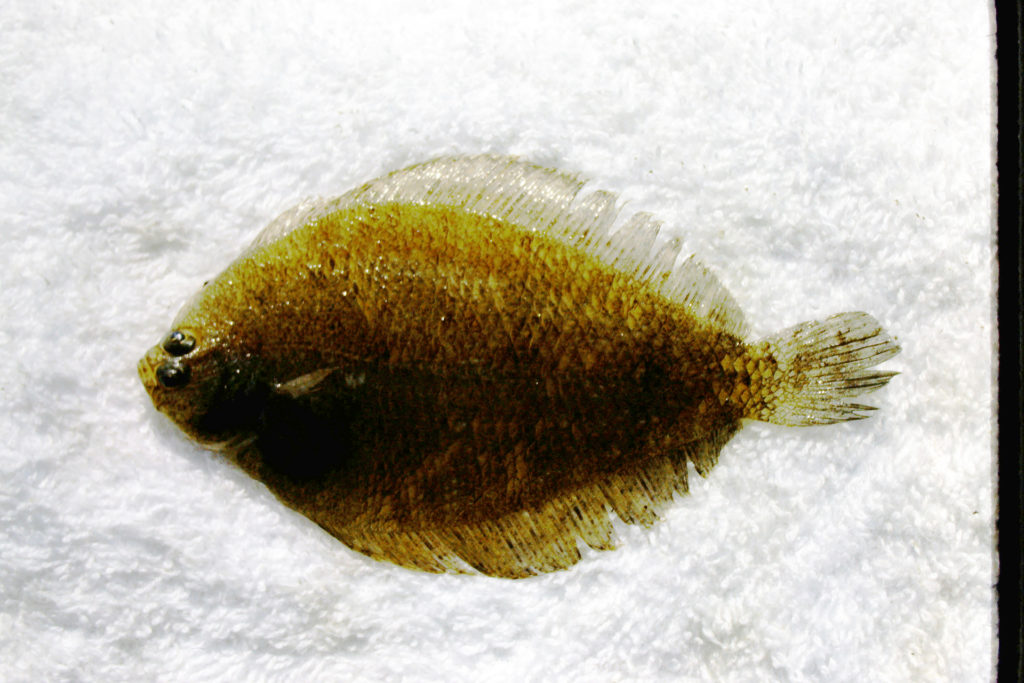| Family | Scientific Name | Author | Year | Common Name |
| Paralichthyidae | Etropus rimosus | Goode and Bean | 1885 | Gray Flounder |
Etropus rimosus
Unique Characters: No distinct arch in lateral line above pectoral fin on ocular side and lateral line not prolonged below inferior eye. Base of pelvic fin on ocular side on midventral line. Urinary papilla on blind side. Branched caudal-fin rays 11, rarely 10 or 12. Mouth small, maxilla 3.5-4.2 in head length nearly reaching vertical through front margin of eye. Jaws on blind side arched. No enlarged teeth; front teeth in both jaws equal in size to lateral teeth. Snout with scales forward of a line between ocular- and blind-side nostrils in fishes greater than 30 mm standard length. Ctenii on snout scales highly modified, especially in large males. Primary scales of blind side ctenoid, but ctenii may be indistinct on fish less than 50 mm standard length. Accessory scales present; accessory scales cover 3/4 of exposed surface of primary scales in fish larger than about 60 mm standard length. Mandible not symmetrical. Gill rakers on lower limb of first arch 3-6 (rarely 7). Number of gill rakers on upper limb of first arch usually exceeds number on lower limb. Greatest body depth usually more than 50% standard length. Without dark circles on ocular side.
Similar Species:
Fringed Flounder Etropus crossotus
Smallmouth Flounder
Etropus microstomus
Shelf Flounder
Etropus cyclosquamus
Fringed Flounder Etropus crossotus. No distinct arch in lateral line above pectoral fin on ocular side and lateral line not prolonged below inferior eye. Base of pelvic fin on ocular side on midventral line. Urinary papilla on blind side. Branched caudal-fin rays 11, rarely 10 or 12. Mouth small, maxilla 3.5-4.2 in head length nearly reaching vertical through front margin of eye. Jaws on blind side arched. No enlarged teeth; front teeth in both jaws equal in size to lateral teeth. Accessory scales absent. Gill rakers on lower limb of first arch 6-9, modally 7 or 8. Without scales on snout.
Smallmouth Flounder Etropus microstomus. No distinct arch in lateral line above pectoral fin on ocular side and lateral line not prolonged below inferior eye. Base of pelvic fin on ocular side on midventral line. Urinary papilla on blind side. Branched caudal-fin rays 11, rarely 10 or 12. Mouth small, maxilla 3.5-4.2 in head length nearly reaching vertical through front margin of eye. Jaws on blind side arched. No enlarged teeth; front teeth in both jaws equal in size to lateral teeth. Scales on snout. Accessory scales present; accessory scales cover 1/2 or less of exposed surface of primary scales in fish larger than about 60 mm standard length. Gill rakers on lower limb of first arch 3-6 (rarely 7). Number of gill rakers on upper limb of first arch usually equal to or less than number on lower limb. Mandible relatively symmetrical. Greatest body depth usually less than 50% standard length.
Shelf Flounder Etropus cyclosquamus. No distinct arch in lateral line above pectoral fin on ocular side and lateral line not prolonged below inferior eye. Base of pelvic fin on ocular side on midventral line. Urinary papilla on blind side. Branched caudal-fin rays 11, rarely 10 or 12. Mouth small, maxilla 3.5-4.2 in head length nearly reaching vertical through front margin of eye. Jaws on blind side arched. No enlarged teeth; front teeth in both jaws equal in size to lateral teeth. Snout without scales forward of a line between ocular- and blind-side nostrils in fishes greater than 30 mm standard length, or rarely, with 1 or 2 scales present in large specimens. Ctenii on snout scales simple; primary scales of blind side cycloid. Accessory scales present; accessory scales cover 3/4 of exposed surface of primary scales in fish larger than about 60 mm standard length. Gill rakers on lower limb of first arch 3-6 (rarely 7); with scales on snout; number of gill rakers on upper limb of first arch usually exceeds number on lower limb. Mandible not symmetrical. Greatest body depth usually more than 50% standard length. Often with row of four to six small dark circles on ocular side above and below lateral line, but circles may be indistinct on fish collected over dark substrate.
Gallery
